Project Management Assessment C - Module Report, University Name
VerifiedAdded on 2022/08/18
|17
|4197
|14
Report
AI Summary
This report delves into the core principles of project management, offering a detailed analysis of various critical aspects. It begins by differentiating between projects and processes, highlighting their unique characteristics and applications. The report then explores the Internal Rate of Return (IRR) as a metric for evaluating project profitability, discussing its advantages and disadvantages. It further examines strategies for building and motivating project teams, including the stages of group development and the associated project management behaviors. The report also covers project budgeting techniques, comparing top-down and bottom-up approaches and their respective benefits. Finally, it addresses resource scheduling in a multi-project environment, outlining common heuristics used to optimize resource allocation and manage potential conflicts. Overall, this report provides a comprehensive overview of essential project management concepts and practices.
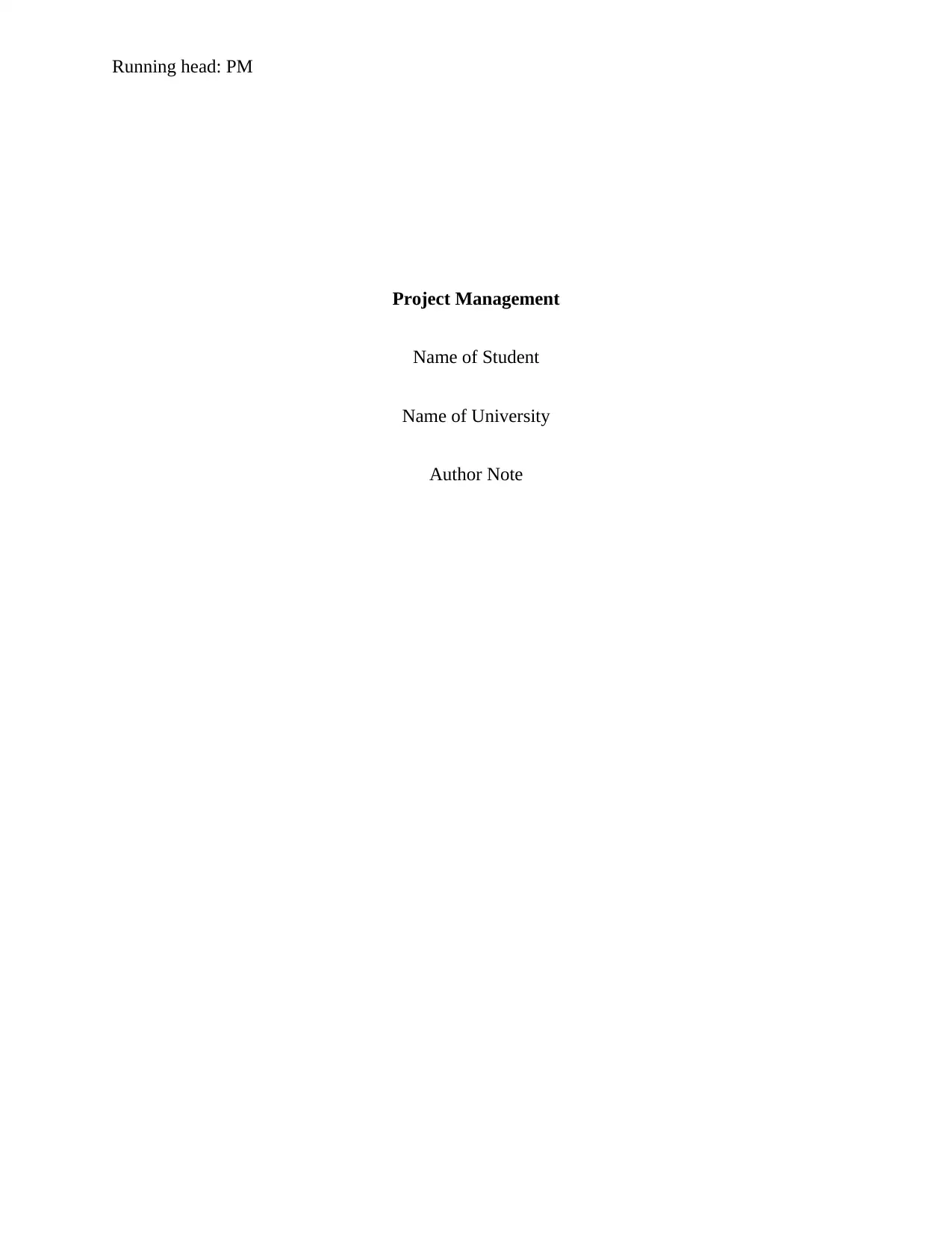
Running head: PM
Project Management
Name of Student
Name of University
Author Note
Project Management
Name of Student
Name of University
Author Note
Paraphrase This Document
Need a fresh take? Get an instant paraphrase of this document with our AI Paraphraser
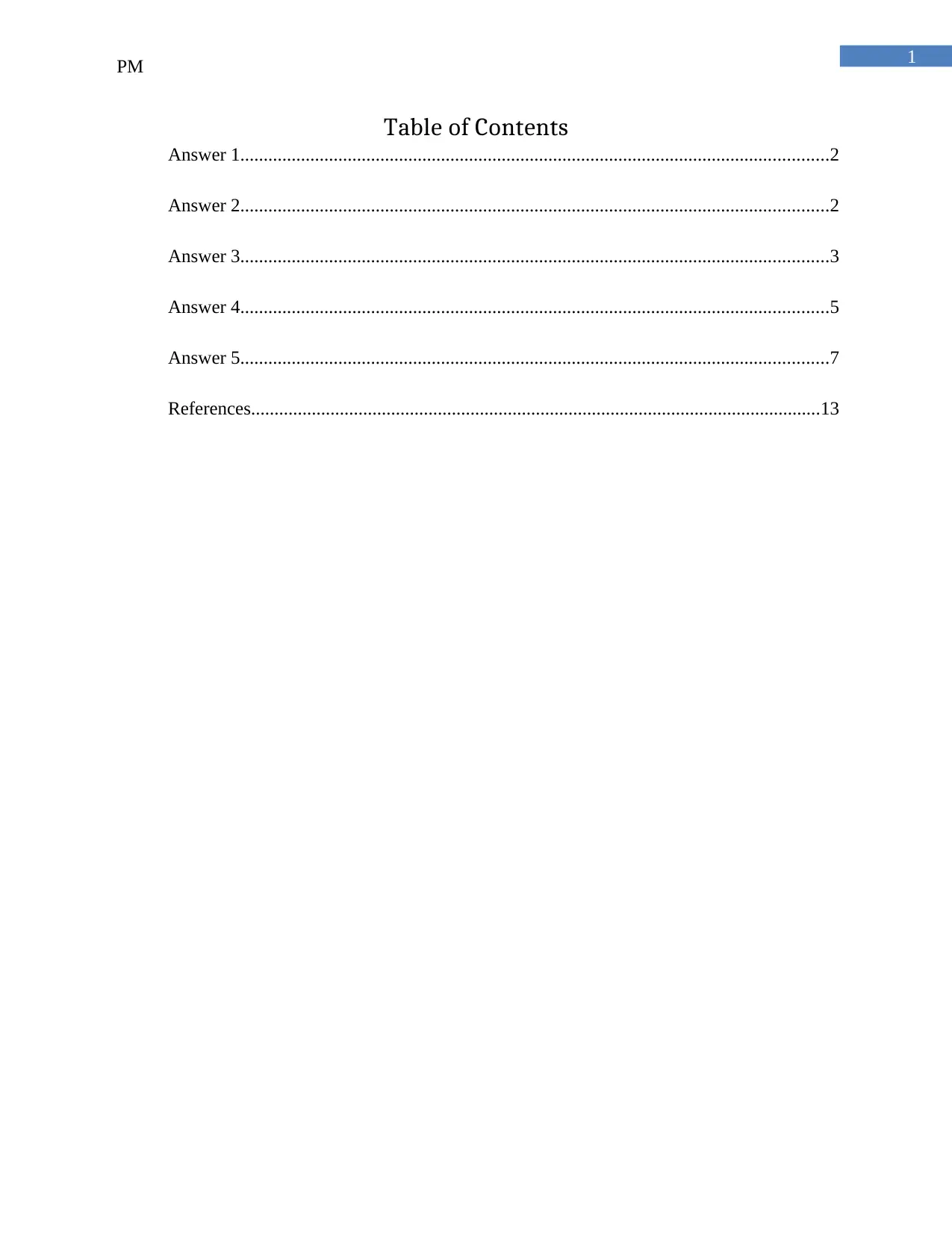
1
PM
Table of Contents
Answer 1..............................................................................................................................2
Answer 2..............................................................................................................................2
Answer 3..............................................................................................................................3
Answer 4..............................................................................................................................5
Answer 5..............................................................................................................................7
References..........................................................................................................................13
PM
Table of Contents
Answer 1..............................................................................................................................2
Answer 2..............................................................................................................................2
Answer 3..............................................................................................................................3
Answer 4..............................................................................................................................5
Answer 5..............................................................................................................................7
References..........................................................................................................................13
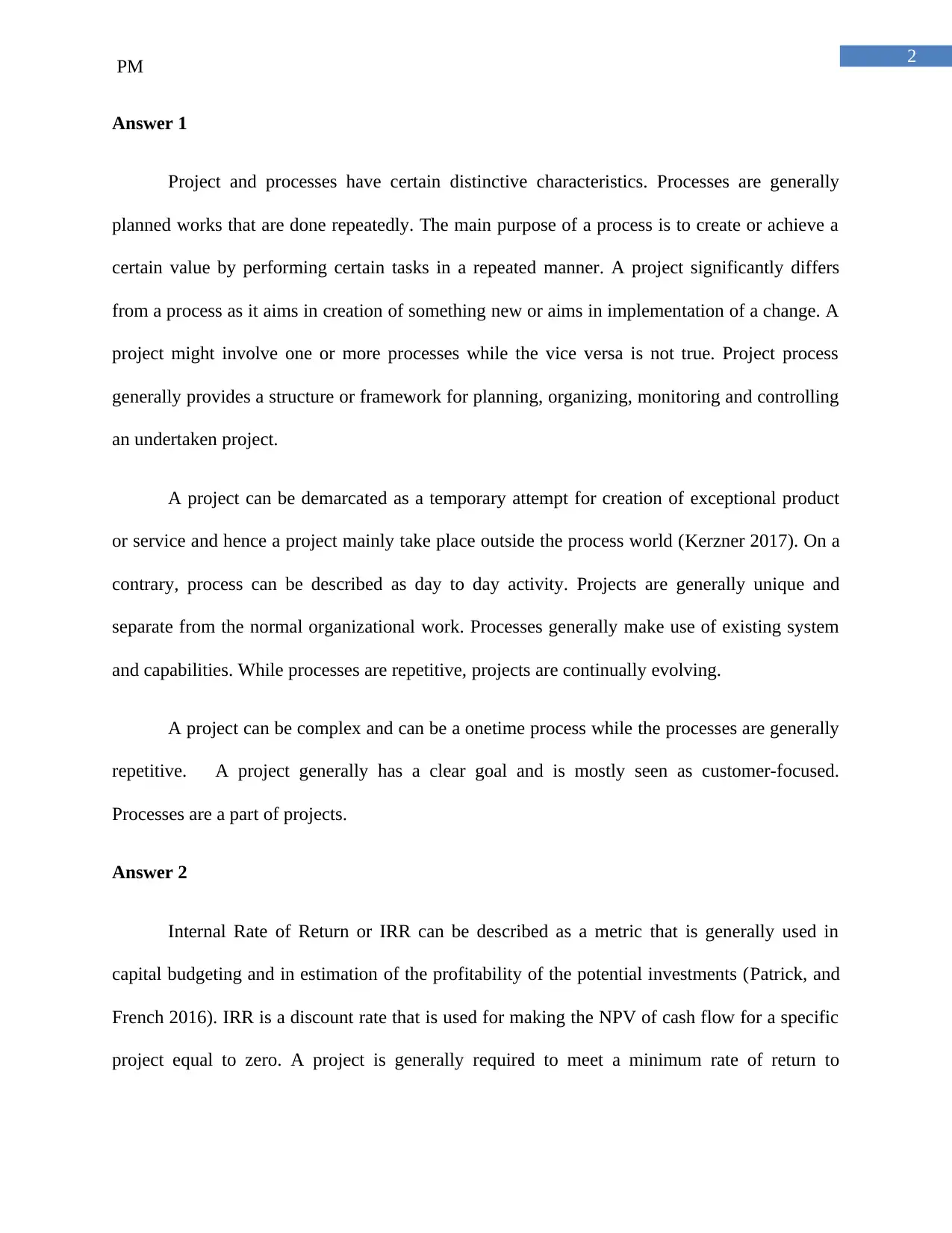
2
PM
Answer 1
Project and processes have certain distinctive characteristics. Processes are generally
planned works that are done repeatedly. The main purpose of a process is to create or achieve a
certain value by performing certain tasks in a repeated manner. A project significantly differs
from a process as it aims in creation of something new or aims in implementation of a change. A
project might involve one or more processes while the vice versa is not true. Project process
generally provides a structure or framework for planning, organizing, monitoring and controlling
an undertaken project.
A project can be demarcated as a temporary attempt for creation of exceptional product
or service and hence a project mainly take place outside the process world (Kerzner 2017). On a
contrary, process can be described as day to day activity. Projects are generally unique and
separate from the normal organizational work. Processes generally make use of existing system
and capabilities. While processes are repetitive, projects are continually evolving.
A project can be complex and can be a onetime process while the processes are generally
repetitive. A project generally has a clear goal and is mostly seen as customer-focused.
Processes are a part of projects.
Answer 2
Internal Rate of Return or IRR can be described as a metric that is generally used in
capital budgeting and in estimation of the profitability of the potential investments (Patrick, and
French 2016). IRR is a discount rate that is used for making the NPV of cash flow for a specific
project equal to zero. A project is generally required to meet a minimum rate of return to
PM
Answer 1
Project and processes have certain distinctive characteristics. Processes are generally
planned works that are done repeatedly. The main purpose of a process is to create or achieve a
certain value by performing certain tasks in a repeated manner. A project significantly differs
from a process as it aims in creation of something new or aims in implementation of a change. A
project might involve one or more processes while the vice versa is not true. Project process
generally provides a structure or framework for planning, organizing, monitoring and controlling
an undertaken project.
A project can be demarcated as a temporary attempt for creation of exceptional product
or service and hence a project mainly take place outside the process world (Kerzner 2017). On a
contrary, process can be described as day to day activity. Projects are generally unique and
separate from the normal organizational work. Processes generally make use of existing system
and capabilities. While processes are repetitive, projects are continually evolving.
A project can be complex and can be a onetime process while the processes are generally
repetitive. A project generally has a clear goal and is mostly seen as customer-focused.
Processes are a part of projects.
Answer 2
Internal Rate of Return or IRR can be described as a metric that is generally used in
capital budgeting and in estimation of the profitability of the potential investments (Patrick, and
French 2016). IRR is a discount rate that is used for making the NPV of cash flow for a specific
project equal to zero. A project is generally required to meet a minimum rate of return to
⊘ This is a preview!⊘
Do you want full access?
Subscribe today to unlock all pages.

Trusted by 1+ million students worldwide
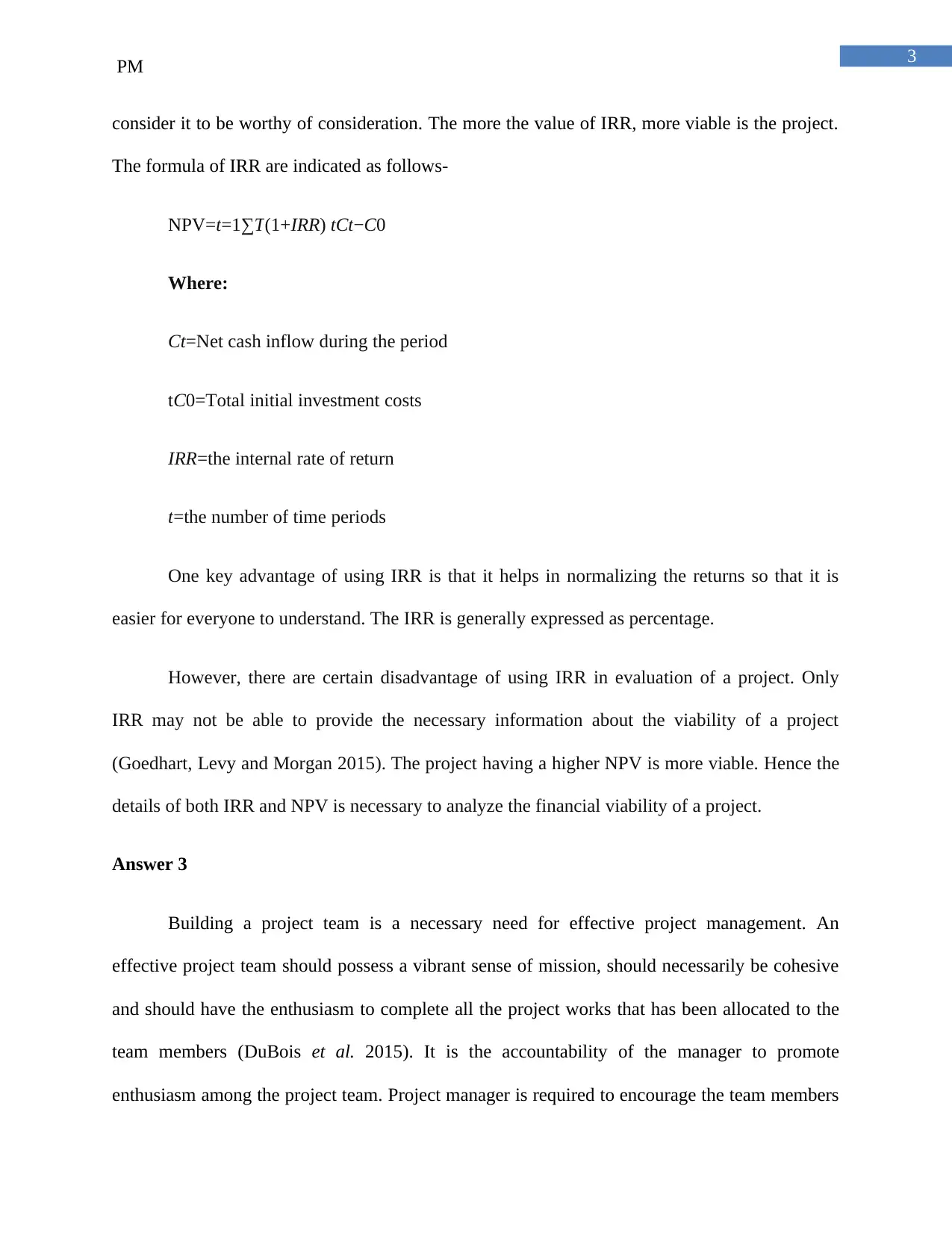
3
PM
consider it to be worthy of consideration. The more the value of IRR, more viable is the project.
The formula of IRR are indicated as follows-
NPV=t=1∑T(1+IRR) tCt−C0
Where:
Ct=Net cash inflow during the period
tC0=Total initial investment costs
IRR=the internal rate of return
t=the number of time periods
One key advantage of using IRR is that it helps in normalizing the returns so that it is
easier for everyone to understand. The IRR is generally expressed as percentage.
However, there are certain disadvantage of using IRR in evaluation of a project. Only
IRR may not be able to provide the necessary information about the viability of a project
(Goedhart, Levy and Morgan 2015). The project having a higher NPV is more viable. Hence the
details of both IRR and NPV is necessary to analyze the financial viability of a project.
Answer 3
Building a project team is a necessary need for effective project management. An
effective project team should possess a vibrant sense of mission, should necessarily be cohesive
and should have the enthusiasm to complete all the project works that has been allocated to the
team members (DuBois et al. 2015). It is the accountability of the manager to promote
enthusiasm among the project team. Project manager is required to encourage the team members
PM
consider it to be worthy of consideration. The more the value of IRR, more viable is the project.
The formula of IRR are indicated as follows-
NPV=t=1∑T(1+IRR) tCt−C0
Where:
Ct=Net cash inflow during the period
tC0=Total initial investment costs
IRR=the internal rate of return
t=the number of time periods
One key advantage of using IRR is that it helps in normalizing the returns so that it is
easier for everyone to understand. The IRR is generally expressed as percentage.
However, there are certain disadvantage of using IRR in evaluation of a project. Only
IRR may not be able to provide the necessary information about the viability of a project
(Goedhart, Levy and Morgan 2015). The project having a higher NPV is more viable. Hence the
details of both IRR and NPV is necessary to analyze the financial viability of a project.
Answer 3
Building a project team is a necessary need for effective project management. An
effective project team should possess a vibrant sense of mission, should necessarily be cohesive
and should have the enthusiasm to complete all the project works that has been allocated to the
team members (DuBois et al. 2015). It is the accountability of the manager to promote
enthusiasm among the project team. Project manager is required to encourage the team members
Paraphrase This Document
Need a fresh take? Get an instant paraphrase of this document with our AI Paraphraser
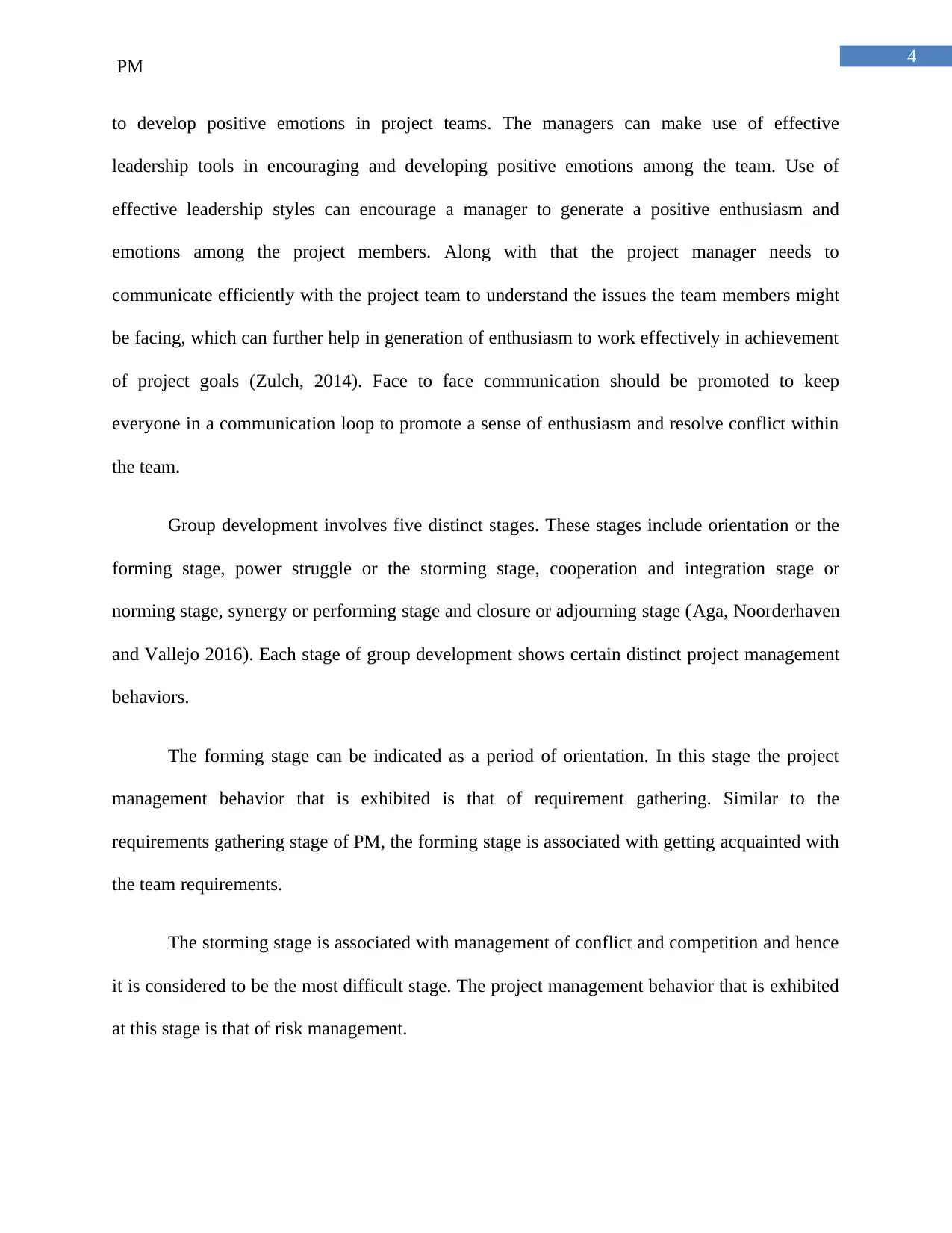
4
PM
to develop positive emotions in project teams. The managers can make use of effective
leadership tools in encouraging and developing positive emotions among the team. Use of
effective leadership styles can encourage a manager to generate a positive enthusiasm and
emotions among the project members. Along with that the project manager needs to
communicate efficiently with the project team to understand the issues the team members might
be facing, which can further help in generation of enthusiasm to work effectively in achievement
of project goals (Zulch, 2014). Face to face communication should be promoted to keep
everyone in a communication loop to promote a sense of enthusiasm and resolve conflict within
the team.
Group development involves five distinct stages. These stages include orientation or the
forming stage, power struggle or the storming stage, cooperation and integration stage or
norming stage, synergy or performing stage and closure or adjourning stage (Aga, Noorderhaven
and Vallejo 2016). Each stage of group development shows certain distinct project management
behaviors.
The forming stage can be indicated as a period of orientation. In this stage the project
management behavior that is exhibited is that of requirement gathering. Similar to the
requirements gathering stage of PM, the forming stage is associated with getting acquainted with
the team requirements.
The storming stage is associated with management of conflict and competition and hence
it is considered to be the most difficult stage. The project management behavior that is exhibited
at this stage is that of risk management.
PM
to develop positive emotions in project teams. The managers can make use of effective
leadership tools in encouraging and developing positive emotions among the team. Use of
effective leadership styles can encourage a manager to generate a positive enthusiasm and
emotions among the project members. Along with that the project manager needs to
communicate efficiently with the project team to understand the issues the team members might
be facing, which can further help in generation of enthusiasm to work effectively in achievement
of project goals (Zulch, 2014). Face to face communication should be promoted to keep
everyone in a communication loop to promote a sense of enthusiasm and resolve conflict within
the team.
Group development involves five distinct stages. These stages include orientation or the
forming stage, power struggle or the storming stage, cooperation and integration stage or
norming stage, synergy or performing stage and closure or adjourning stage (Aga, Noorderhaven
and Vallejo 2016). Each stage of group development shows certain distinct project management
behaviors.
The forming stage can be indicated as a period of orientation. In this stage the project
management behavior that is exhibited is that of requirement gathering. Similar to the
requirements gathering stage of PM, the forming stage is associated with getting acquainted with
the team requirements.
The storming stage is associated with management of conflict and competition and hence
it is considered to be the most difficult stage. The project management behavior that is exhibited
at this stage is that of risk management.
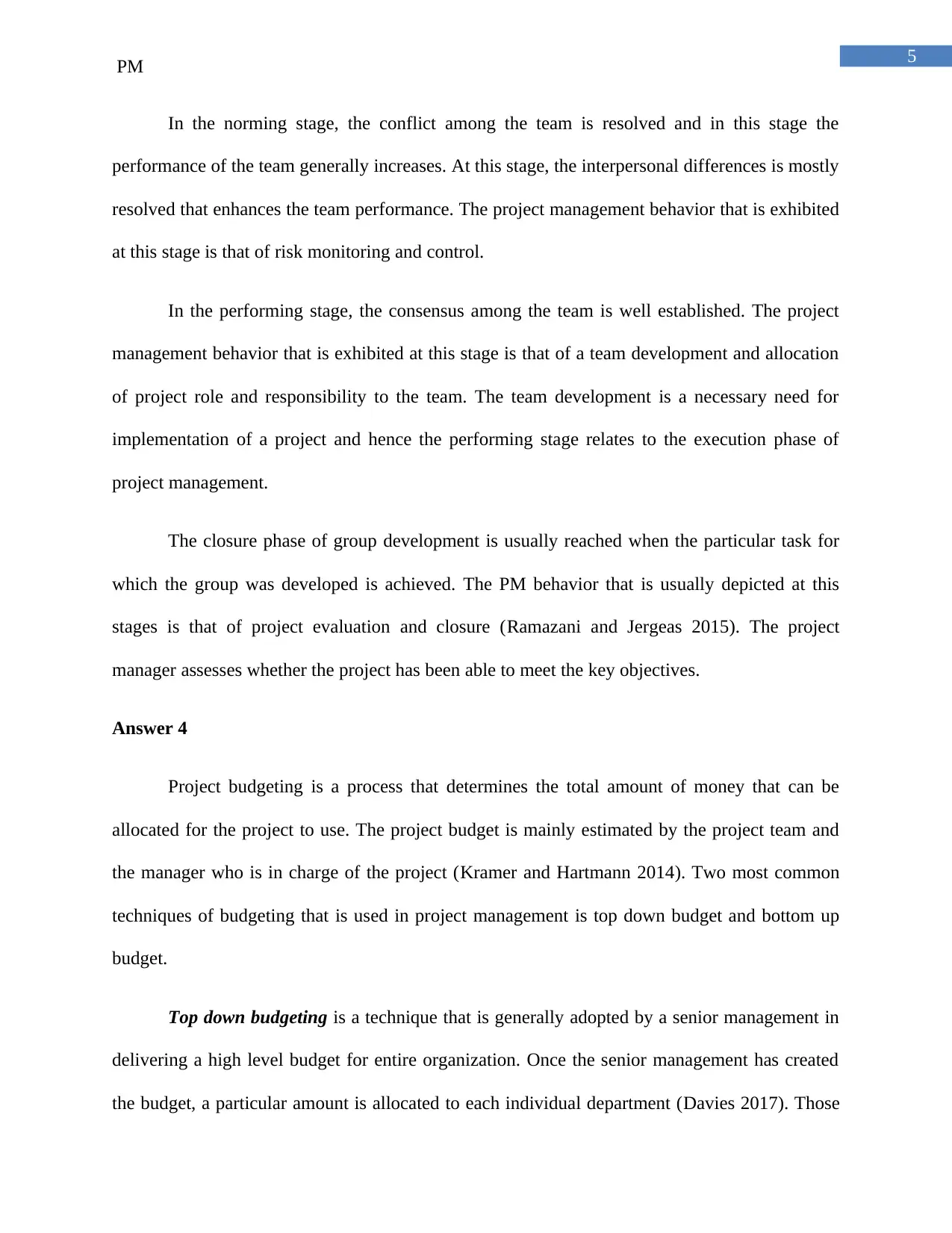
5
PM
In the norming stage, the conflict among the team is resolved and in this stage the
performance of the team generally increases. At this stage, the interpersonal differences is mostly
resolved that enhances the team performance. The project management behavior that is exhibited
at this stage is that of risk monitoring and control.
In the performing stage, the consensus among the team is well established. The project
management behavior that is exhibited at this stage is that of a team development and allocation
of project role and responsibility to the team. The team development is a necessary need for
implementation of a project and hence the performing stage relates to the execution phase of
project management.
The closure phase of group development is usually reached when the particular task for
which the group was developed is achieved. The PM behavior that is usually depicted at this
stages is that of project evaluation and closure (Ramazani and Jergeas 2015). The project
manager assesses whether the project has been able to meet the key objectives.
Answer 4
Project budgeting is a process that determines the total amount of money that can be
allocated for the project to use. The project budget is mainly estimated by the project team and
the manager who is in charge of the project (Kramer and Hartmann 2014). Two most common
techniques of budgeting that is used in project management is top down budget and bottom up
budget.
Top down budgeting is a technique that is generally adopted by a senior management in
delivering a high level budget for entire organization. Once the senior management has created
the budget, a particular amount is allocated to each individual department (Davies 2017). Those
PM
In the norming stage, the conflict among the team is resolved and in this stage the
performance of the team generally increases. At this stage, the interpersonal differences is mostly
resolved that enhances the team performance. The project management behavior that is exhibited
at this stage is that of risk monitoring and control.
In the performing stage, the consensus among the team is well established. The project
management behavior that is exhibited at this stage is that of a team development and allocation
of project role and responsibility to the team. The team development is a necessary need for
implementation of a project and hence the performing stage relates to the execution phase of
project management.
The closure phase of group development is usually reached when the particular task for
which the group was developed is achieved. The PM behavior that is usually depicted at this
stages is that of project evaluation and closure (Ramazani and Jergeas 2015). The project
manager assesses whether the project has been able to meet the key objectives.
Answer 4
Project budgeting is a process that determines the total amount of money that can be
allocated for the project to use. The project budget is mainly estimated by the project team and
the manager who is in charge of the project (Kramer and Hartmann 2014). Two most common
techniques of budgeting that is used in project management is top down budget and bottom up
budget.
Top down budgeting is a technique that is generally adopted by a senior management in
delivering a high level budget for entire organization. Once the senior management has created
the budget, a particular amount is allocated to each individual department (Davies 2017). Those
⊘ This is a preview!⊘
Do you want full access?
Subscribe today to unlock all pages.

Trusted by 1+ million students worldwide
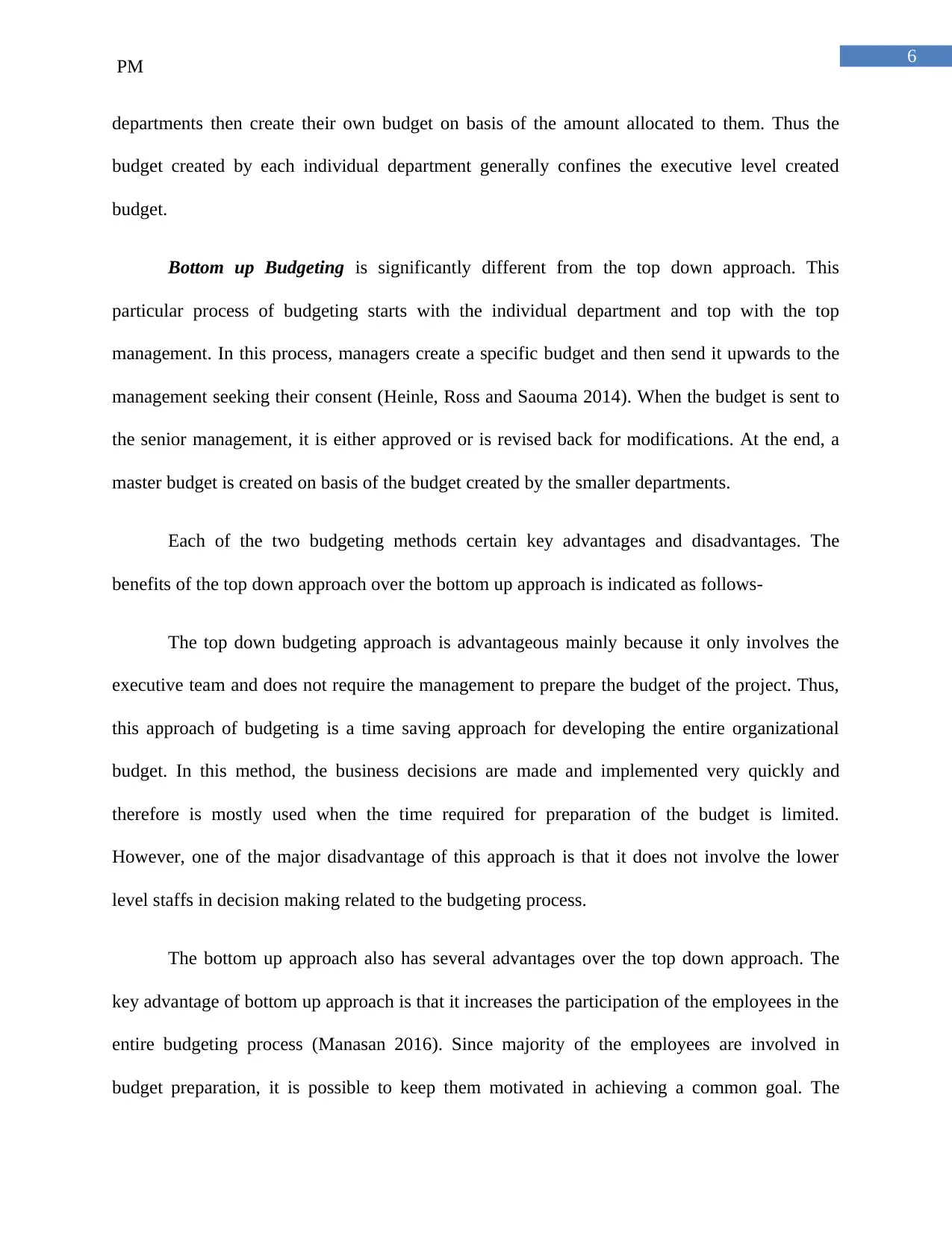
6
PM
departments then create their own budget on basis of the amount allocated to them. Thus the
budget created by each individual department generally confines the executive level created
budget.
Bottom up Budgeting is significantly different from the top down approach. This
particular process of budgeting starts with the individual department and top with the top
management. In this process, managers create a specific budget and then send it upwards to the
management seeking their consent (Heinle, Ross and Saouma 2014). When the budget is sent to
the senior management, it is either approved or is revised back for modifications. At the end, a
master budget is created on basis of the budget created by the smaller departments.
Each of the two budgeting methods certain key advantages and disadvantages. The
benefits of the top down approach over the bottom up approach is indicated as follows-
The top down budgeting approach is advantageous mainly because it only involves the
executive team and does not require the management to prepare the budget of the project. Thus,
this approach of budgeting is a time saving approach for developing the entire organizational
budget. In this method, the business decisions are made and implemented very quickly and
therefore is mostly used when the time required for preparation of the budget is limited.
However, one of the major disadvantage of this approach is that it does not involve the lower
level staffs in decision making related to the budgeting process.
The bottom up approach also has several advantages over the top down approach. The
key advantage of bottom up approach is that it increases the participation of the employees in the
entire budgeting process (Manasan 2016). Since majority of the employees are involved in
budget preparation, it is possible to keep them motivated in achieving a common goal. The
PM
departments then create their own budget on basis of the amount allocated to them. Thus the
budget created by each individual department generally confines the executive level created
budget.
Bottom up Budgeting is significantly different from the top down approach. This
particular process of budgeting starts with the individual department and top with the top
management. In this process, managers create a specific budget and then send it upwards to the
management seeking their consent (Heinle, Ross and Saouma 2014). When the budget is sent to
the senior management, it is either approved or is revised back for modifications. At the end, a
master budget is created on basis of the budget created by the smaller departments.
Each of the two budgeting methods certain key advantages and disadvantages. The
benefits of the top down approach over the bottom up approach is indicated as follows-
The top down budgeting approach is advantageous mainly because it only involves the
executive team and does not require the management to prepare the budget of the project. Thus,
this approach of budgeting is a time saving approach for developing the entire organizational
budget. In this method, the business decisions are made and implemented very quickly and
therefore is mostly used when the time required for preparation of the budget is limited.
However, one of the major disadvantage of this approach is that it does not involve the lower
level staffs in decision making related to the budgeting process.
The bottom up approach also has several advantages over the top down approach. The
key advantage of bottom up approach is that it increases the participation of the employees in the
entire budgeting process (Manasan 2016). Since majority of the employees are involved in
budget preparation, it is possible to keep them motivated in achieving a common goal. The
Paraphrase This Document
Need a fresh take? Get an instant paraphrase of this document with our AI Paraphraser
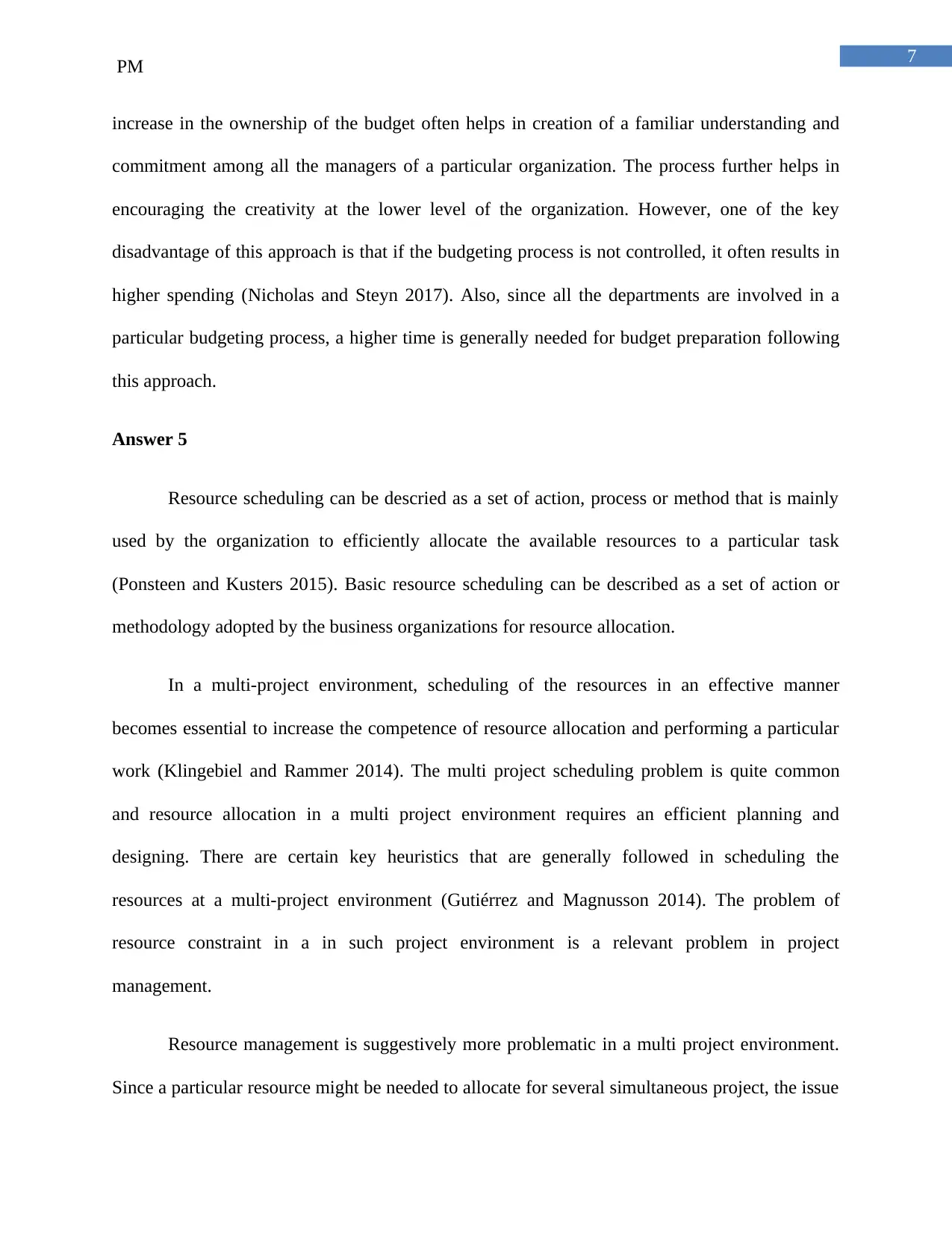
7
PM
increase in the ownership of the budget often helps in creation of a familiar understanding and
commitment among all the managers of a particular organization. The process further helps in
encouraging the creativity at the lower level of the organization. However, one of the key
disadvantage of this approach is that if the budgeting process is not controlled, it often results in
higher spending (Nicholas and Steyn 2017). Also, since all the departments are involved in a
particular budgeting process, a higher time is generally needed for budget preparation following
this approach.
Answer 5
Resource scheduling can be descried as a set of action, process or method that is mainly
used by the organization to efficiently allocate the available resources to a particular task
(Ponsteen and Kusters 2015). Basic resource scheduling can be described as a set of action or
methodology adopted by the business organizations for resource allocation.
In a multi-project environment, scheduling of the resources in an effective manner
becomes essential to increase the competence of resource allocation and performing a particular
work (Klingebiel and Rammer 2014). The multi project scheduling problem is quite common
and resource allocation in a multi project environment requires an efficient planning and
designing. There are certain key heuristics that are generally followed in scheduling the
resources at a multi-project environment (Gutiérrez and Magnusson 2014). The problem of
resource constraint in a in such project environment is a relevant problem in project
management.
Resource management is suggestively more problematic in a multi project environment.
Since a particular resource might be needed to allocate for several simultaneous project, the issue
PM
increase in the ownership of the budget often helps in creation of a familiar understanding and
commitment among all the managers of a particular organization. The process further helps in
encouraging the creativity at the lower level of the organization. However, one of the key
disadvantage of this approach is that if the budgeting process is not controlled, it often results in
higher spending (Nicholas and Steyn 2017). Also, since all the departments are involved in a
particular budgeting process, a higher time is generally needed for budget preparation following
this approach.
Answer 5
Resource scheduling can be descried as a set of action, process or method that is mainly
used by the organization to efficiently allocate the available resources to a particular task
(Ponsteen and Kusters 2015). Basic resource scheduling can be described as a set of action or
methodology adopted by the business organizations for resource allocation.
In a multi-project environment, scheduling of the resources in an effective manner
becomes essential to increase the competence of resource allocation and performing a particular
work (Klingebiel and Rammer 2014). The multi project scheduling problem is quite common
and resource allocation in a multi project environment requires an efficient planning and
designing. There are certain key heuristics that are generally followed in scheduling the
resources at a multi-project environment (Gutiérrez and Magnusson 2014). The problem of
resource constraint in a in such project environment is a relevant problem in project
management.
Resource management is suggestively more problematic in a multi project environment.
Since a particular resource might be needed to allocate for several simultaneous project, the issue
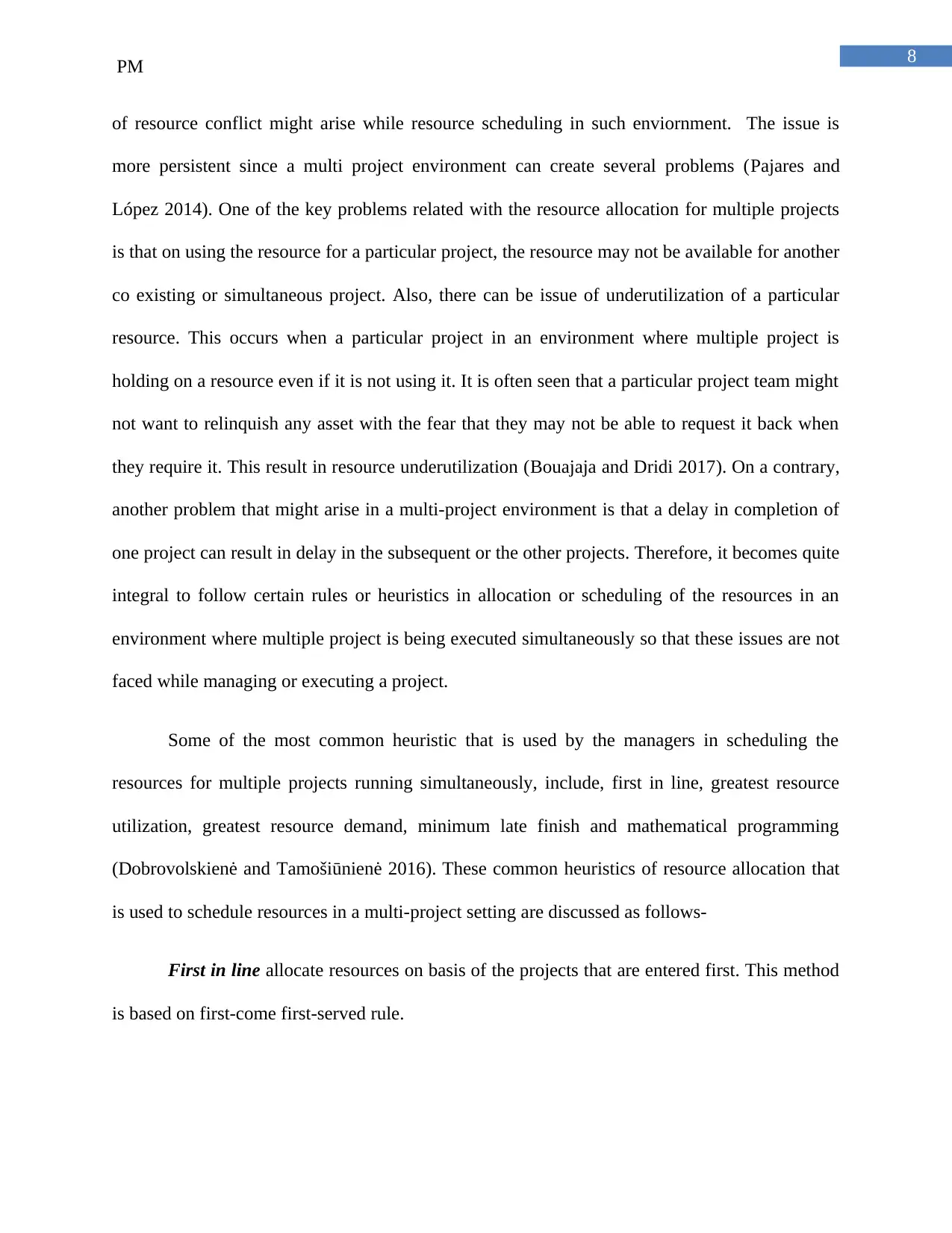
8
PM
of resource conflict might arise while resource scheduling in such enviornment. The issue is
more persistent since a multi project environment can create several problems (Pajares and
López 2014). One of the key problems related with the resource allocation for multiple projects
is that on using the resource for a particular project, the resource may not be available for another
co existing or simultaneous project. Also, there can be issue of underutilization of a particular
resource. This occurs when a particular project in an environment where multiple project is
holding on a resource even if it is not using it. It is often seen that a particular project team might
not want to relinquish any asset with the fear that they may not be able to request it back when
they require it. This result in resource underutilization (Bouajaja and Dridi 2017). On a contrary,
another problem that might arise in a multi-project environment is that a delay in completion of
one project can result in delay in the subsequent or the other projects. Therefore, it becomes quite
integral to follow certain rules or heuristics in allocation or scheduling of the resources in an
environment where multiple project is being executed simultaneously so that these issues are not
faced while managing or executing a project.
Some of the most common heuristic that is used by the managers in scheduling the
resources for multiple projects running simultaneously, include, first in line, greatest resource
utilization, greatest resource demand, minimum late finish and mathematical programming
(Dobrovolskienė and Tamošiūnienė 2016). These common heuristics of resource allocation that
is used to schedule resources in a multi-project setting are discussed as follows-
First in line allocate resources on basis of the projects that are entered first. This method
is based on first-come first-served rule.
PM
of resource conflict might arise while resource scheduling in such enviornment. The issue is
more persistent since a multi project environment can create several problems (Pajares and
López 2014). One of the key problems related with the resource allocation for multiple projects
is that on using the resource for a particular project, the resource may not be available for another
co existing or simultaneous project. Also, there can be issue of underutilization of a particular
resource. This occurs when a particular project in an environment where multiple project is
holding on a resource even if it is not using it. It is often seen that a particular project team might
not want to relinquish any asset with the fear that they may not be able to request it back when
they require it. This result in resource underutilization (Bouajaja and Dridi 2017). On a contrary,
another problem that might arise in a multi-project environment is that a delay in completion of
one project can result in delay in the subsequent or the other projects. Therefore, it becomes quite
integral to follow certain rules or heuristics in allocation or scheduling of the resources in an
environment where multiple project is being executed simultaneously so that these issues are not
faced while managing or executing a project.
Some of the most common heuristic that is used by the managers in scheduling the
resources for multiple projects running simultaneously, include, first in line, greatest resource
utilization, greatest resource demand, minimum late finish and mathematical programming
(Dobrovolskienė and Tamošiūnienė 2016). These common heuristics of resource allocation that
is used to schedule resources in a multi-project setting are discussed as follows-
First in line allocate resources on basis of the projects that are entered first. This method
is based on first-come first-served rule.
⊘ This is a preview!⊘
Do you want full access?
Subscribe today to unlock all pages.

Trusted by 1+ million students worldwide
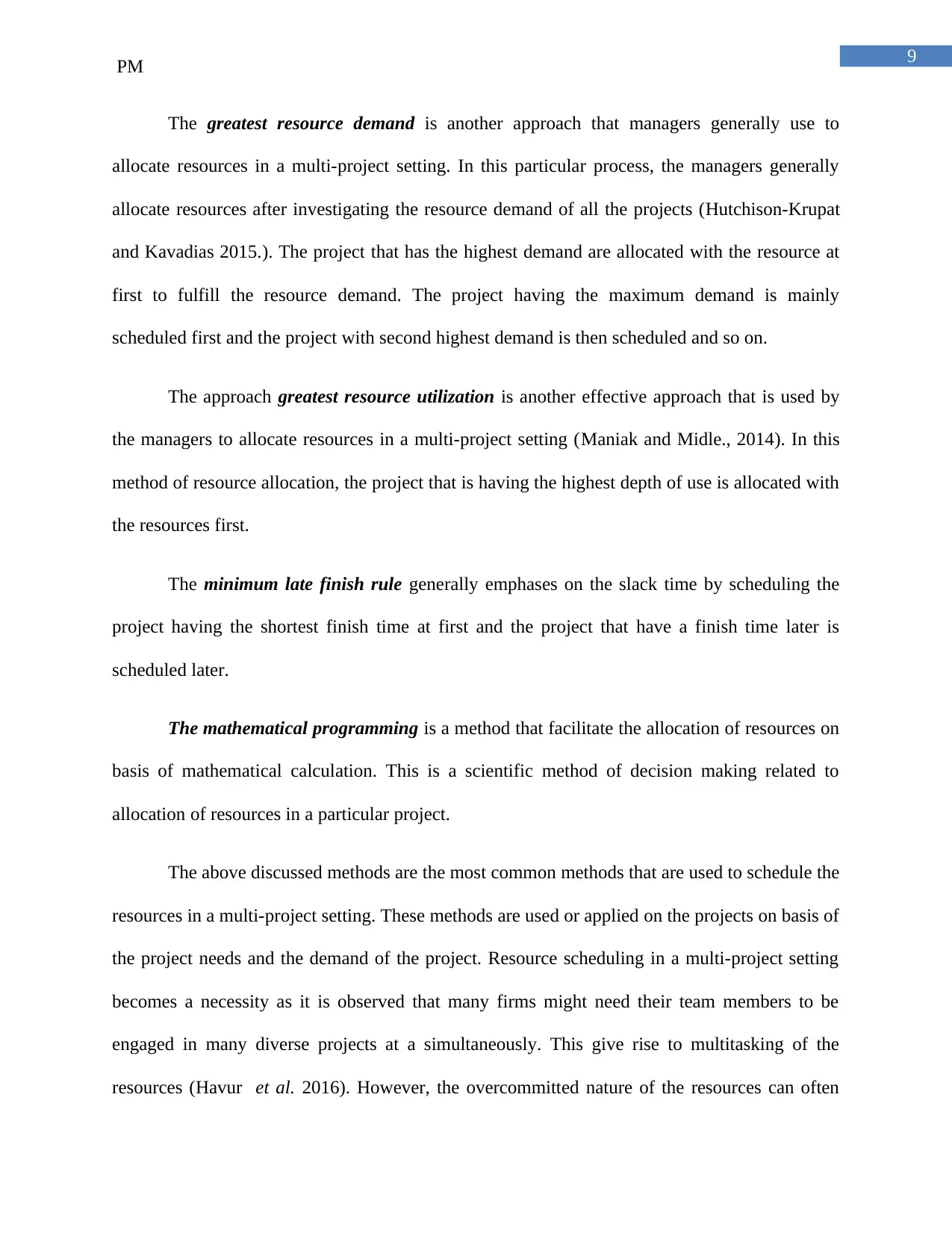
9
PM
The greatest resource demand is another approach that managers generally use to
allocate resources in a multi-project setting. In this particular process, the managers generally
allocate resources after investigating the resource demand of all the projects (Hutchison-Krupat
and Kavadias 2015.). The project that has the highest demand are allocated with the resource at
first to fulfill the resource demand. The project having the maximum demand is mainly
scheduled first and the project with second highest demand is then scheduled and so on.
The approach greatest resource utilization is another effective approach that is used by
the managers to allocate resources in a multi-project setting (Maniak and Midle., 2014). In this
method of resource allocation, the project that is having the highest depth of use is allocated with
the resources first.
The minimum late finish rule generally emphases on the slack time by scheduling the
project having the shortest finish time at first and the project that have a finish time later is
scheduled later.
The mathematical programming is a method that facilitate the allocation of resources on
basis of mathematical calculation. This is a scientific method of decision making related to
allocation of resources in a particular project.
The above discussed methods are the most common methods that are used to schedule the
resources in a multi-project setting. These methods are used or applied on the projects on basis of
the project needs and the demand of the project. Resource scheduling in a multi-project setting
becomes a necessity as it is observed that many firms might need their team members to be
engaged in many diverse projects at a simultaneously. This give rise to multitasking of the
resources (Havur et al. 2016). However, the overcommitted nature of the resources can often
PM
The greatest resource demand is another approach that managers generally use to
allocate resources in a multi-project setting. In this particular process, the managers generally
allocate resources after investigating the resource demand of all the projects (Hutchison-Krupat
and Kavadias 2015.). The project that has the highest demand are allocated with the resource at
first to fulfill the resource demand. The project having the maximum demand is mainly
scheduled first and the project with second highest demand is then scheduled and so on.
The approach greatest resource utilization is another effective approach that is used by
the managers to allocate resources in a multi-project setting (Maniak and Midle., 2014). In this
method of resource allocation, the project that is having the highest depth of use is allocated with
the resources first.
The minimum late finish rule generally emphases on the slack time by scheduling the
project having the shortest finish time at first and the project that have a finish time later is
scheduled later.
The mathematical programming is a method that facilitate the allocation of resources on
basis of mathematical calculation. This is a scientific method of decision making related to
allocation of resources in a particular project.
The above discussed methods are the most common methods that are used to schedule the
resources in a multi-project setting. These methods are used or applied on the projects on basis of
the project needs and the demand of the project. Resource scheduling in a multi-project setting
becomes a necessity as it is observed that many firms might need their team members to be
engaged in many diverse projects at a simultaneously. This give rise to multitasking of the
resources (Havur et al. 2016). However, the overcommitted nature of the resources can often
Paraphrase This Document
Need a fresh take? Get an instant paraphrase of this document with our AI Paraphraser
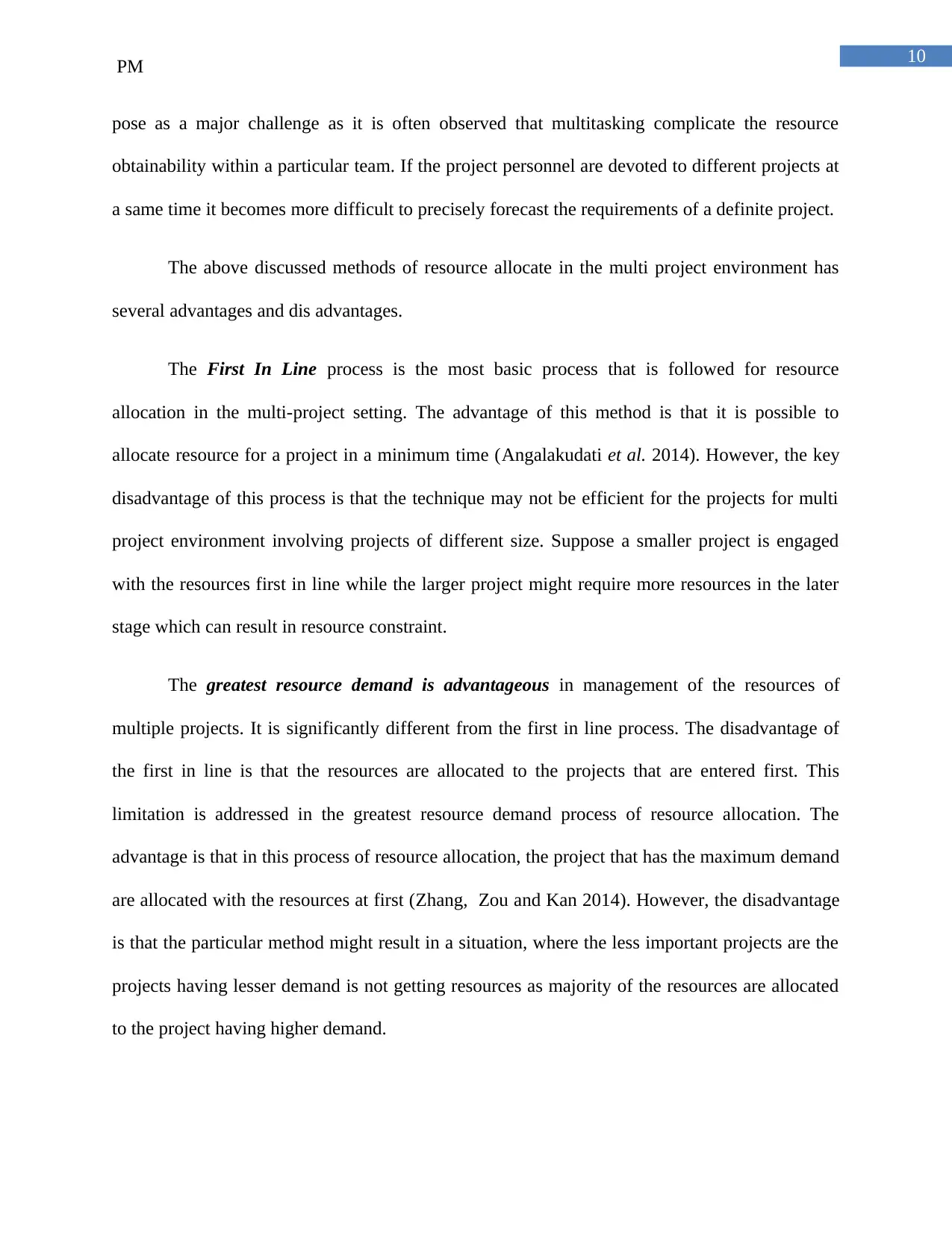
10
PM
pose as a major challenge as it is often observed that multitasking complicate the resource
obtainability within a particular team. If the project personnel are devoted to different projects at
a same time it becomes more difficult to precisely forecast the requirements of a definite project.
The above discussed methods of resource allocate in the multi project environment has
several advantages and dis advantages.
The First In Line process is the most basic process that is followed for resource
allocation in the multi-project setting. The advantage of this method is that it is possible to
allocate resource for a project in a minimum time (Angalakudati et al. 2014). However, the key
disadvantage of this process is that the technique may not be efficient for the projects for multi
project environment involving projects of different size. Suppose a smaller project is engaged
with the resources first in line while the larger project might require more resources in the later
stage which can result in resource constraint.
The greatest resource demand is advantageous in management of the resources of
multiple projects. It is significantly different from the first in line process. The disadvantage of
the first in line is that the resources are allocated to the projects that are entered first. This
limitation is addressed in the greatest resource demand process of resource allocation. The
advantage is that in this process of resource allocation, the project that has the maximum demand
are allocated with the resources at first (Zhang, Zou and Kan 2014). However, the disadvantage
is that the particular method might result in a situation, where the less important projects are the
projects having lesser demand is not getting resources as majority of the resources are allocated
to the project having higher demand.
PM
pose as a major challenge as it is often observed that multitasking complicate the resource
obtainability within a particular team. If the project personnel are devoted to different projects at
a same time it becomes more difficult to precisely forecast the requirements of a definite project.
The above discussed methods of resource allocate in the multi project environment has
several advantages and dis advantages.
The First In Line process is the most basic process that is followed for resource
allocation in the multi-project setting. The advantage of this method is that it is possible to
allocate resource for a project in a minimum time (Angalakudati et al. 2014). However, the key
disadvantage of this process is that the technique may not be efficient for the projects for multi
project environment involving projects of different size. Suppose a smaller project is engaged
with the resources first in line while the larger project might require more resources in the later
stage which can result in resource constraint.
The greatest resource demand is advantageous in management of the resources of
multiple projects. It is significantly different from the first in line process. The disadvantage of
the first in line is that the resources are allocated to the projects that are entered first. This
limitation is addressed in the greatest resource demand process of resource allocation. The
advantage is that in this process of resource allocation, the project that has the maximum demand
are allocated with the resources at first (Zhang, Zou and Kan 2014). However, the disadvantage
is that the particular method might result in a situation, where the less important projects are the
projects having lesser demand is not getting resources as majority of the resources are allocated
to the project having higher demand.
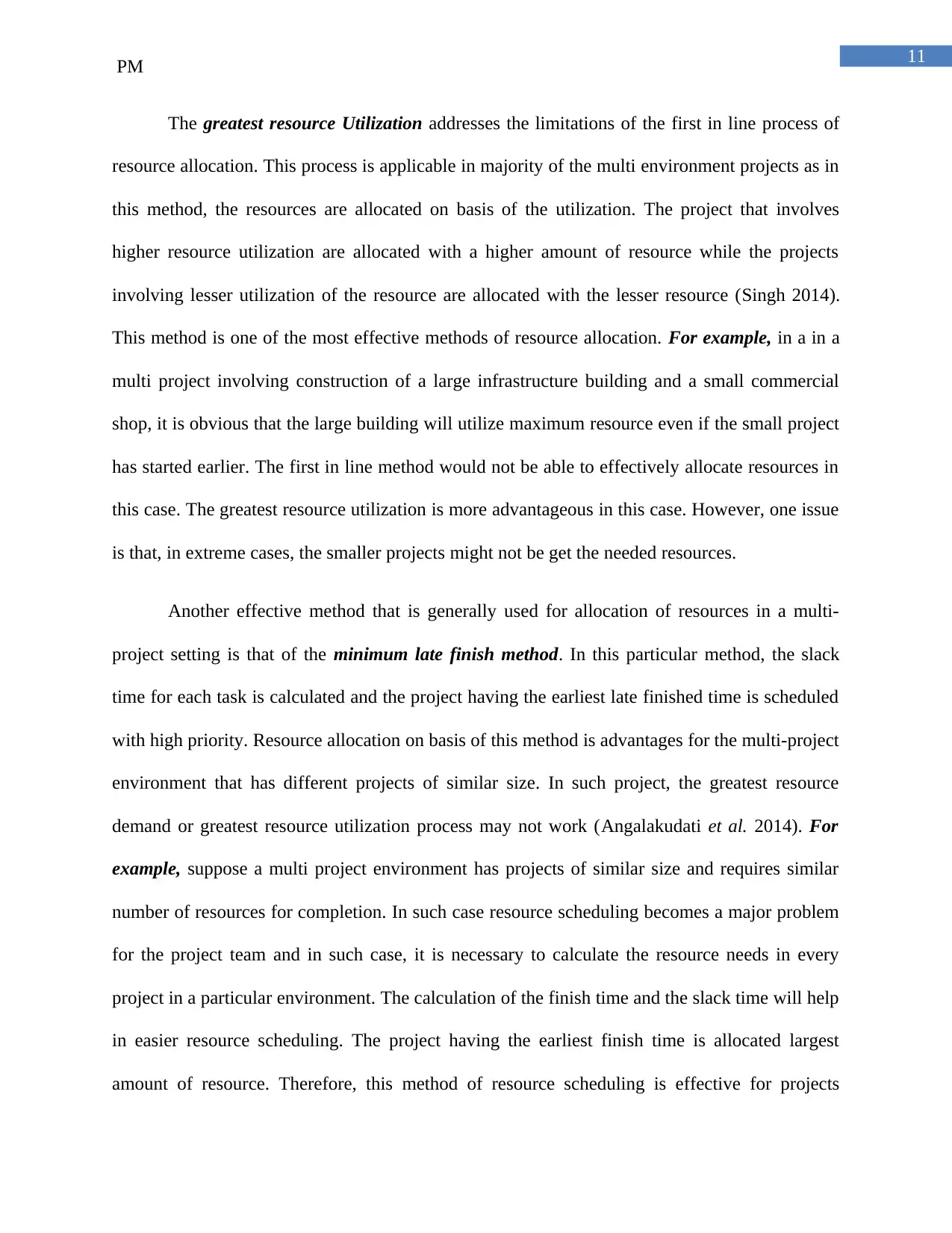
11
PM
The greatest resource Utilization addresses the limitations of the first in line process of
resource allocation. This process is applicable in majority of the multi environment projects as in
this method, the resources are allocated on basis of the utilization. The project that involves
higher resource utilization are allocated with a higher amount of resource while the projects
involving lesser utilization of the resource are allocated with the lesser resource (Singh 2014).
This method is one of the most effective methods of resource allocation. For example, in a in a
multi project involving construction of a large infrastructure building and a small commercial
shop, it is obvious that the large building will utilize maximum resource even if the small project
has started earlier. The first in line method would not be able to effectively allocate resources in
this case. The greatest resource utilization is more advantageous in this case. However, one issue
is that, in extreme cases, the smaller projects might not be get the needed resources.
Another effective method that is generally used for allocation of resources in a multi-
project setting is that of the minimum late finish method. In this particular method, the slack
time for each task is calculated and the project having the earliest late finished time is scheduled
with high priority. Resource allocation on basis of this method is advantages for the multi-project
environment that has different projects of similar size. In such project, the greatest resource
demand or greatest resource utilization process may not work (Angalakudati et al. 2014). For
example, suppose a multi project environment has projects of similar size and requires similar
number of resources for completion. In such case resource scheduling becomes a major problem
for the project team and in such case, it is necessary to calculate the resource needs in every
project in a particular environment. The calculation of the finish time and the slack time will help
in easier resource scheduling. The project having the earliest finish time is allocated largest
amount of resource. Therefore, this method of resource scheduling is effective for projects
PM
The greatest resource Utilization addresses the limitations of the first in line process of
resource allocation. This process is applicable in majority of the multi environment projects as in
this method, the resources are allocated on basis of the utilization. The project that involves
higher resource utilization are allocated with a higher amount of resource while the projects
involving lesser utilization of the resource are allocated with the lesser resource (Singh 2014).
This method is one of the most effective methods of resource allocation. For example, in a in a
multi project involving construction of a large infrastructure building and a small commercial
shop, it is obvious that the large building will utilize maximum resource even if the small project
has started earlier. The first in line method would not be able to effectively allocate resources in
this case. The greatest resource utilization is more advantageous in this case. However, one issue
is that, in extreme cases, the smaller projects might not be get the needed resources.
Another effective method that is generally used for allocation of resources in a multi-
project setting is that of the minimum late finish method. In this particular method, the slack
time for each task is calculated and the project having the earliest late finished time is scheduled
with high priority. Resource allocation on basis of this method is advantages for the multi-project
environment that has different projects of similar size. In such project, the greatest resource
demand or greatest resource utilization process may not work (Angalakudati et al. 2014). For
example, suppose a multi project environment has projects of similar size and requires similar
number of resources for completion. In such case resource scheduling becomes a major problem
for the project team and in such case, it is necessary to calculate the resource needs in every
project in a particular environment. The calculation of the finish time and the slack time will help
in easier resource scheduling. The project having the earliest finish time is allocated largest
amount of resource. Therefore, this method of resource scheduling is effective for projects
⊘ This is a preview!⊘
Do you want full access?
Subscribe today to unlock all pages.

Trusted by 1+ million students worldwide
1 out of 17
Related Documents
Your All-in-One AI-Powered Toolkit for Academic Success.
+13062052269
info@desklib.com
Available 24*7 on WhatsApp / Email
![[object Object]](/_next/static/media/star-bottom.7253800d.svg)
Unlock your academic potential
Copyright © 2020–2025 A2Z Services. All Rights Reserved. Developed and managed by ZUCOL.




